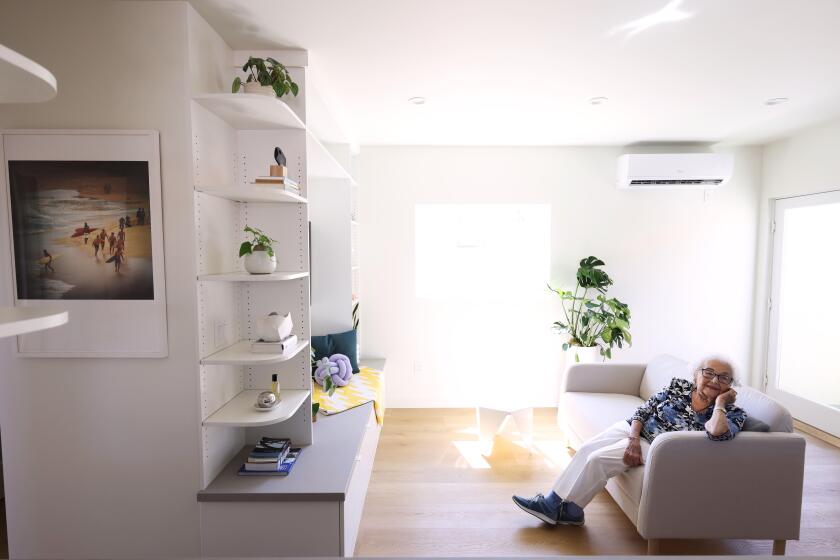There’s Nothing Like a New Ballpark
KANSAS CITY, Mo. — The ballpark.
To this kid, that would be Milwaukee County Stadium.
Sitting with Dad in the upper grandstand, down the first-base line. Trying to decide if Hank Aaron is a better hero because that quick flick-of-the-wrist swing is going to make him Home Run King or if it should be Warren Spahn because he’s a lefty, too.
Generations of kids have lifelong memories of days at the ballpark.
Those memories for the next generation will come from a new generation of ballparks--most if not all of them designed by HOK Sport of Kansas City.
HOK, just finished with the new Comiskey Park in Chicago, is hard at work on the new Camden Yards park in Baltimore and will do a new stadium in Cleveland once financial problems are worked out. And, yes, a new Milwaukee County Stadium is scheduled.
Meanwhile, there’s the $100 million Royal Hong Kong Jockey Club under construction in Hong Kong.
Not to mention a new stadium in Chicago for the NBA champion Bulls and many other facilities across the nation -- both major league and minor league.
Basically, if you need something to play in, HOK are the people to call.
Rick deFlon, principal architect of Comiskey, says the critical new idea of the new baseball parks is that baseball and football cannot be played in the same stadium.
That multipurpose notion resulted in the “concrete doughnuts” -- the stadia in the round like Busch Stadium in St. Louis, Riverfront Stadium in Cincinnati, Three Rivers Stadium in Pittsburgh and Veterans Stadium in Philadelphia.
“I don’t think I can criticize the architects of the concrete doughnuts,” deFlon said from his office in a restored, historic building downtown. “At the time they were built, municipalities wanted dual-purpose stadiums.
“But I don’t think the round stadiums stand the test of time. They don’t work for the football fan who needs to be at the 50-yard-line and for the baseball fan who needs to be close to the lines.”
deFlon emphasizes there will be no HOK-style stadium: the architects design what their clients want. And, for baseball, people these days want old-style ballparks that preserve the intimacy of the game while including all the modern conveniences, he says.
“We wanted a state of the art building that looked like the old Comiskey,” said Terry Savarise, vice president for stadium operations for the White Sox. “We wanted a building that fit in with the neighborhood. Baseball parks have a charm. We wanted to maintain the intimacy.”
Said deFlon: “It’s a return to the past. These are parks, not baseball stadiums. They’re intimate, close.”
Football is different because it doesn’t have the history of baseball and because the design of the stadium doesn’t affect the game, deFlon says. There are no quirky corners, Big Green Monsters or vine-covered walls in football stadiums.
Baseball design has reached a fourth generation, he says.
There are the very old stadiums like Wrigley Field, Fenway and Tiger Stadium -- “Model T’s are nice to take a drive in on a Sunday, but I wouldn’t want to drive it all week,” deFlon said.
There are the round stadiums and the domed stadiums.
Then there are the new generation, which eliminate posts that obscure the view and try to get as many seats as close to the field as possible.
“We want to create an intimacy of space,” deFlon said. “You can do that with size, with the colors that you use, with enclosure.”
HOK has grown from deFlon and his five partners in 1983 to an office employing 140 architects now. It’s a division of the architectural company Hellmuth, Obata & Kassabaum, Inc. and one of only two or three firms nationwide that specialize in stadium design.
“We’re well enough known now that if there is a project, we usually get a call,” deFlon said.
Although HOK offices are housed in an old building, everything is very up-to-date inside.
In the bright, two-level work area, architects use a sophisticated computer system to design their projects. A representation of a stadium under design, the new Chicago Stadium for example, can be called up on the computer, and an architect can duplicate sight lines from any seat.
Building such large projects can, of course, be complicated.
There’s appeasing various political interests in the area involved, working on financing and dealing with local public interest groups.
HOK, for example, worked hard to defend the site it selected in Baltimore for Camden Yards.
“The nature of architectural design is solving problems,” deFlon said. “The frustrating thing is dealing with people who make decisions for the wrong reasons. People who make decisions based on some political consideration. The problem is these projects are so important they transcend politics.”
Some of the players are having trouble adjusting to the new Comiskey. Mike Macfarlane of the Royals says it’s too glitzy.
Carlton Fisk of the White Sox said, “There’s a different perception, and the points of reference are farther away.”
But, after all, the parks are for the fans, not the players.
That takes us back to County Stadium.
We’re in the front row, upper deck.
Tony Cloniger is pitching, and nobody much wants to hit this night because he’s as wild as ever with that hard fastball of his.
Cookie Rojas of the Phillies lofts a soft foul ball that seems to hang in the air right in front of us. Dad takes it in just like he’s picking an apple off a tree.
It’s memories that make the park.
More to Read
Go beyond the scoreboard
Get the latest on L.A.'s teams in the daily Sports Report newsletter.
You may occasionally receive promotional content from the Los Angeles Times.










